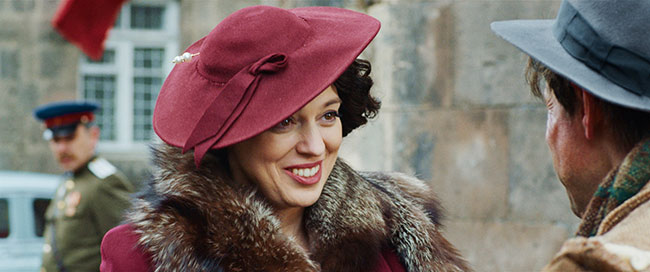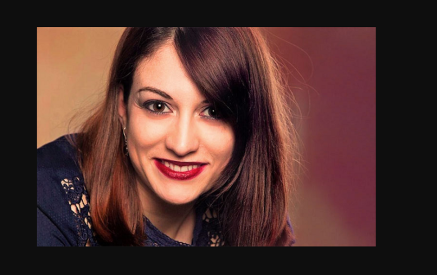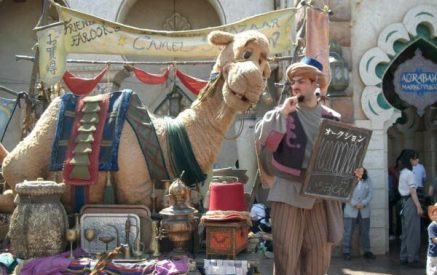The Armenian Mirror-Spectator
by Aram Arkun
WATERTOWN — A full-feature art film made in Armenia is a treat, as post-independence cinema suffered a decline from its status in the Soviet period. “Amerikatsi” (meaning “American” in Armenian) is a new trilingual film (with English, Russian and Armenian dialogue) that is the exception proving the rule. It is a nearly two-hour-long movie filmed in Armenia but with a cast drawn from around the world. It presents Soviet Armenia through the eyes of a fictional repatriate from the United States, an Armenian Genocide survivor as a child, in the late 1940s. He ends up in prison and views life unfolding outside only through a narrow hole in the prison wall.
Emmy-Award winning actor and director Michael Andranik Goorjian, based in San Francisco, wrote the script, directed the film, and starred in it as the main character, the repatriate Charlie. He said, “One of my main goals was to try to do something that would have a chance of reaching non-Armenians….All the terrible things in the past, yes, they are important and need to be talked about and dealt with, but we have so much art and culture and interesting things. These are the things that will help get the kind of attention you seek when you look to the rest of the world.”
Read also
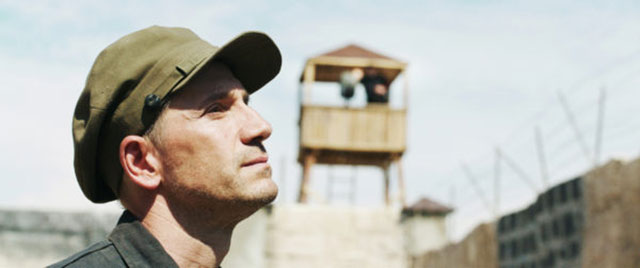
Michael Goorjian as Charlie Bakhchinyan, in the prison yard, in “Amerikatsi”
It took Goorjian a long time to come up with the right story. After his film “Illusion” came out in 2004, Armenians kept asking him when he would make a movie about Armenia. He said, “I have tried over the years. I have thought a lot about different things — maybe I could do this, maybe I could do that. That maybe was always there in the background, a longing to go and make a film there.”
He went to Armenia for the first time in 2006 and screened “Illusion” at the Golden Apricot Film Festival. This was a turning point in his thinking.
Rediscovering Armenia
He is Armenian on his father’s side, and he explained that his paternal grandfather raised his father and uncle to be Americans, because his grandfather wanted to leave behind the bitter parts of the Armenian experience. His grandfather was from village called Palu, and as a child he used to steal the local pasha’s horse for joy rides until the Turks came to the village and said they were looking for Manoog Goorjian in order to kill him in retribution. A Turkish family helped him hide and sneaked him out of town, and eventually he came to America, but the rest of his family were all killed in 1915. His wife, Michael’s grandmother, was from Erzurum. She survived the deportations along with a few relatives and made it eventually to Toronto where she met Manoog.
Partly because of all of this, Goorjian did not go much to church growing up or have much contact with Armenians. He visited some cousins and went to a few bazaars now and then. He said, “I didn’t really have any connection to anything Armenian until after college, even till my thirties. An Armenian producer named Anahid Nazarian cast me in a film that she helped produce [“Pomegranate”], and that got me exposed a little bit more to Armenians, but it really was my trip to Armenian in 2006 that changed things. Now, my son goes to an Armenian school, and the whole thing. I am working on learning the language too.”
Mirror-Spectator correspondent Artsvi Bakhchinyan had served as Goorjian’s guide in Armenia (see his own article of March 17, 2022) and helped arrange a screening of the film for the deputy minister of culture at the time, who happened to also share the surname Goorjian. “After watching the film,” Michael related, “he said, we are related, and the rest of my time there I was taken to dinners, and everything was great.”
Writing the Script
“With the script itself, I actually started out with a story which had nothing to do with Armenians. The story is about a prisoner. It was based on a real story a friend of mine told me, about a guy he knew in prison who could see into an apartment. There was a man living there, and the guy vicariously survived learning about this man’s life. To me that core story is both something poetic and universal,” Goorjian said.
It can expose things about the human condition, and the longing to see another life one wants to live. Goorjian said that especially after the Covid experience, many people could relate to such a situation. At the same time, it allowed him through this device to present aspects of Armenian culture, including food and dance, through the eyes of the prisoner to a broad audience in a non-didactic manner.
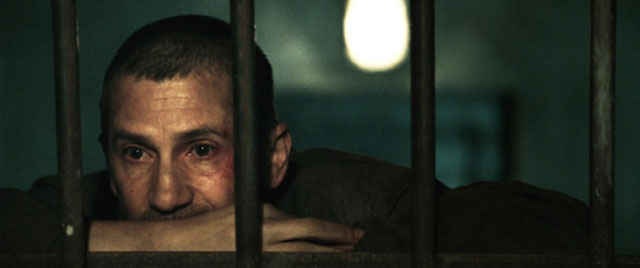
Michael Goorjian as Charlie Bakhchinyan, peering out from his prison cell
“I took that, and I learned about repatriation to Armenia and that period of history, and it fit with this story. On the surface it does look like, oh, this is a movie about a somewhat obscure period of modern Armenian history, but that is kind of the wrapping. The soul of the film is something quite different,” he related.
Once he actually started writing, Goorjian said it became one of the fastest he has completed in the first draft because things seemed to converge for him. However, he said, “For me personally, all good writing is revising. I am sure I was up to at least 50-60 revisions. I was constantly revising and constantly learning too.” He got input from both Armenians and non-Armenians on the script. He said, “One of my concerns was that I did not want to wrongly portray what took place in a way that would offend people that were affected by it. I think that is why tonally this is not straight realism. It is running around with a stork egg in an earthquake.”
In other words, Goorjian was not trying to recreate history with his film but has introduced a surrealistic element. As he describes it, “There is an absurdist side to it, which I think for me was important. As much as it is about things that took place, it is more of a fable. It is about the essence, not the reenactment of this guy’s life.”
That freedom from historicity allowed Goorjian to meld pieces from various stories and places. One example he gave is that of the guard Tigran in the movie, who turns out to be an artist censured by the Communist Party for painting churches. That was based on a true story, which befell the grandfather-in-law of one of the film’s producers, Robert Patrick Malkassian.
When he wrote the script, he originally did not plan to cast himself in the main role. Goorjian said, “It just worked out that this was the best way to do the film.” Early in his career, Goorjian said, he found that oftentimes he would work on projects that while fun, he wouldn’t want to watch personally. “I think that is what started me into writing and trying to create my own projects,” he said, which he could care about more. When asked whether directing a film in which he played the main character posed any problems, he simply responded, “I have done it before.”
Funding and Shooting the Film
Goorjian exclaimed, “From the get-go, I wanted as much as possible to have this film identified with Armenia and support Armenia, creating jobs there done by Armenians, whether from the diaspora or from Armenia. I wanted to get as many people on board as possible to identify with the film as theirs and feel ownership of it.” Together with producer Arman Nshanian, who has not only made other films in Armenia but has helped bridge co-productions with people from other countries, Goorjian met with the Armenian Ministry of Culture and the National Cinema Center.
In the beginning, he related, there was some suspicion. The Armenians understood from experience that filmmaking at times can be a shady enterprise and you never know what you might end up with. In an early interview over Zoom, he was asked why the Russians are the bad guys. He said he explained that this is not anti-Russian but is a historic piece. In fact, he went out of his way to cast actual Russian actors from Russia to play the Russian roles.
In the end, the Ministry of Culture and the National Cinema Center agreed to help finance the film. The film turned out to be probably the highest budget film ever shot in Armenia to date, Goorjian said. Financing also came from investors and some foundations.
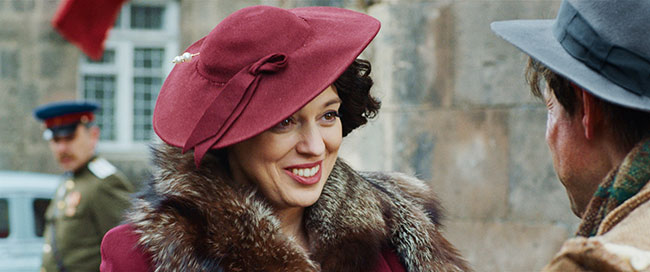
Nelli Uvarova as Sona in “Amerikatsi”
As the film was being shot, Goorjian said, “Slowly, I think people realized that what we were trying to do authentically was a good thing… They saw that the team of people we put together were professionals and our intentions with our project were true in terms of wanting to make good art and wanting to inspire other filmmakers to also come to Armenia and make films there.”
Unlike some filmmakers who bring their own crew from abroad to Armenia, the entire film crew except for Goorjian, the cinematographer, and the first assistant director were all based in Armenia, as was the composer Andranik Berberyan and of course the Armenian Philharmonic.
A number of diasporan Armenians also became involved. One person would introduce Goorjian to another, he related. Bakhchinyan introduced Goorjian to Nelli Uvarova, the Russian actress with an Armenian father who plays Sona in the film.
Filmmaker Karen Hovhannisyan introduced Goorjian to musician Serj Tankian, who became a producer of the film, and in turn connected him with others. Goorjian exclaimed: “This guy is awesome! He helped find tar player Miqayel Voskanyan, and wrote a few of the folk tunes in the film. He in a way supervised the music, but also as a producer, he is not just good in opening doors but really kind — any way that he could help, he helped.”
Chance played a role at times. Finding Hovik Keuchkerian, the actor who played Tigran, took months of searches, until by chance he came across his photo on an Instagram page and realized this was the right person for the role.
However it happened, the final group of actors did a wonderful job. Goorjian said that he screened the film for American actor Bill Murray, who is a friend, and the latter exclaimed, “Those actors are incredible. Down to the smallest role they were great.” Goorjian said that there are so many good actors in Armenia, so he hoped his film would shed light on that.
Goorjian tried to be authentic as much as possible in the film in depicting life in Soviet Armenia, including sets, costumes and in general how things were done then. As much of the film took place in a prison cell, that made his task easier. He relied a lot on the film crew, whose older members had lived through the latter part of the Soviet era. For example, he said that he had blocked and staged all the scenes where a kitchen orderly brings the prisoners’ meals and planned for him to actually come into the cell with the food. However, the man playing that role declared, “I will not put my name on the film, unless the cell door has one of these [slots for trays of food]. Anyone who has lived in Soviet Armenia would know every cell had one.” So Goorjian said he restaged this accordingly.
Language was not seen as a difficulty in this trilingual film. Although Goorjian wrote the original script in English, he had it translated into Armenian for the entire crew and cast. He said he relied a lot on his producer Nshanian and Artvsi Bakhchinyan to help translate for him on the set and also had interpreters to help him a lot of the time, especially as the character he portrays in the film over time learns more and more Armenian.
Difficulties
There were, however, some difficulties while working in Armenia. The infrastructure for filmmaking there has some gaps. When Goorjian first started writing the film, he was forewarned by another filmmaker that he would have to bring his own sound department because they didn’t do sound on sets there. This was a relic of the Soviet era, where films were shot silent and dubbed later.
However, he found out when he was ready to go there to shot that actually there were several teams of people excellent at recording sound, and other improvements took place even during the months he was in Armenia. For example, when he started, there was only one decent ARRI camera in the country and by the time he left there were three.
The preparation of “Amerikatsi” itself also helped improve the situation. The sound stage at Hay Studios was dilapidated and falling apart, according to Goorjian, but his team helped fix the roof as part of the deal for shooting there. The cinematographer told Goorjian that the key grip and gaffer was one of the best that he had ever worked with. However, he did not have direct access to new technical developments abroad, so when the cinematographer introduced him to new lights whose temperatures were easy to adjust, he exclaimed this is incredible. Now he can use this for future productions.
Perhaps the most immediate difficulties the film crew encountered was that when they were a week into shooting, the Covid epidemic first hit, and the crew worried about catching it and possibly dying. Hovik Keuchkerian, who plays the key role of Tigran, was from Madrid, where the epidemic was very severe, and his mother lived there. He had to go back before his parts were finished being shot, and then the Russian actors went back to Russia. Then a travel ban ensued.
Eventually, after some two months of lockdown, when shooting could finally resume, the government only allowed them to shoot the scenes where only one person, Goorjian acting as protagonist Charlie Bakhchinyan, was in his prison cell, as this only required the presence of a handful of people. Goorjian said, “Honestly, of all my years of working, that first day we got to go back to set was one of the best days of shooting I have ever experienced. Everybody was just so glad to be able to work.”
Philosophy and Politics
Goorjian observed that in this movie, which starts with a brief mention of the Armenian Genocide and includes other tragedies like the effects of Stalinism, also references an earthquake. He said, “I remember somebody asking me, why do you have the earthquake in the movie. I answered, well, I wanted to throw everything possible at this guy, because that is what a lot of Armenians feel like – just throw something else at us, what else can we go through.”
However, Goorjian worked on the script during the 2018 Armenian “Velvet Revolution,” and perhaps that had an influence on him too. Goorjian said, “Tonally, the spirit of Armenia before the pandemic and before the war was a sense of euphoria and hope, which is the underlying message of my film. Despite all these horrible things, there is still hope for Armenians to thrive in this world.”

Hovik Keuchkerian as the guard Tigran in “Amerikatsi”
At the same time, there is no political message of the film. He said, “We specifically wanted to make a film that didn’t have a political angle to it. If anything, there is just a call to humanity, especially to Armenians, to have faith in that. The original title which I had was not a great title, but it was “The New Armenian,” and it is from the William Saroyan quote about building a new Armenia any time that two Armenians get together. That is Charlie and Tigran to me. You have to just go back to that foundation of humanity between two Armenians.”
Unexpectedly, the 2020 war broke out a month after the shooting wrapped out. Goorjian said it was tough, because there were both actors and crew that ended up on the front lines. He said, “That I have never experienced before, in Hollywood. I think that made for me the experience of what the film is a little different, as who knows what is going to happen in terms of Armenia.”
Getting the Film Out There
Right now, the film is only being shown in festivals, where it is beginning to receive some acclaim. It was the prestige opening film at the Golden Apricot International Film Festival in July. It won the grand jury prize for best feature narrative and best cinematography at the 23rd annual Woodstock Film Festival in September in upstate New York. On October 8, it won the audience award at the Hamburg Film Festival in Germany. It will be at the Mystic Film Festival in Connecticut, where it will be screened on October 20 and 23, and after this at some festivals on the West Coast.
After the festival phase, Goorjian said, a distribution deal for “Amerikatsi” will be reached with some version of theatrical release at least in the United States, where a lot of Armenians live, before moving on to streaming platforms down the road.
“How we reach our goal of bridging out beyond just our core audience of Armenians is through reaching out first to Armenians and saying, here, we have made this film. We hope you like it and we hope you like the intention of why we made it,” Goorjian said to Armenian readers. “Help us, be our advocate, and help us bridge over to the rest of the world.”
Armenians can support this film by seeing it at festivals and following it on Facebook, Instagram or other social media, since those metrics are significant to distributors. Goorjian concluded, “I tried to make a film that any Armenian can feel is theirs. If people still had DVDs, this would be the film I could see your Armenian grandmother buying a case of and putting copies in stocking stuffers. The ownership of the film being all Armenians in the diaspora, anybody can be proud of it and say, hey, do you want to learn about my culture? Well here, watch this movie.”



















































